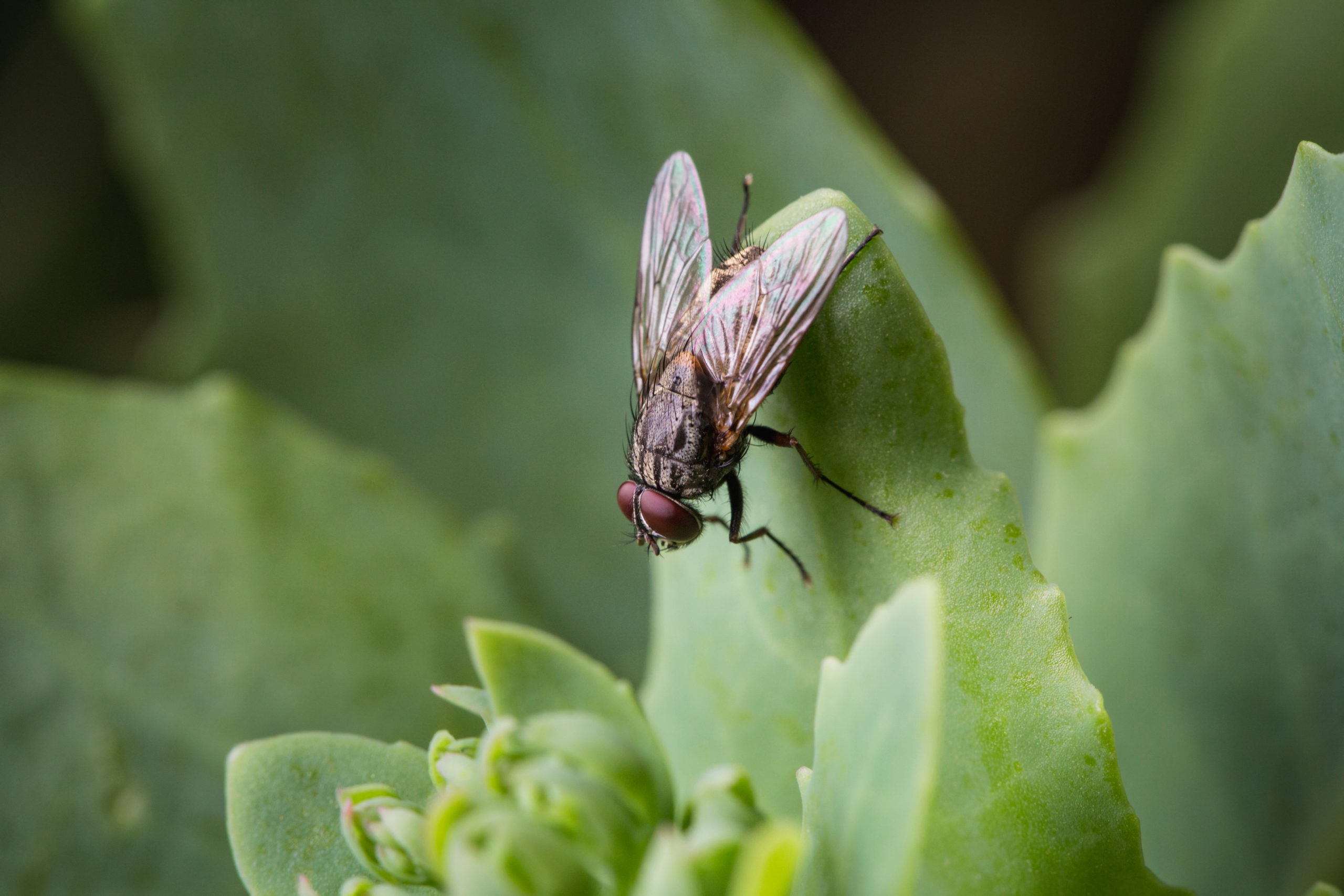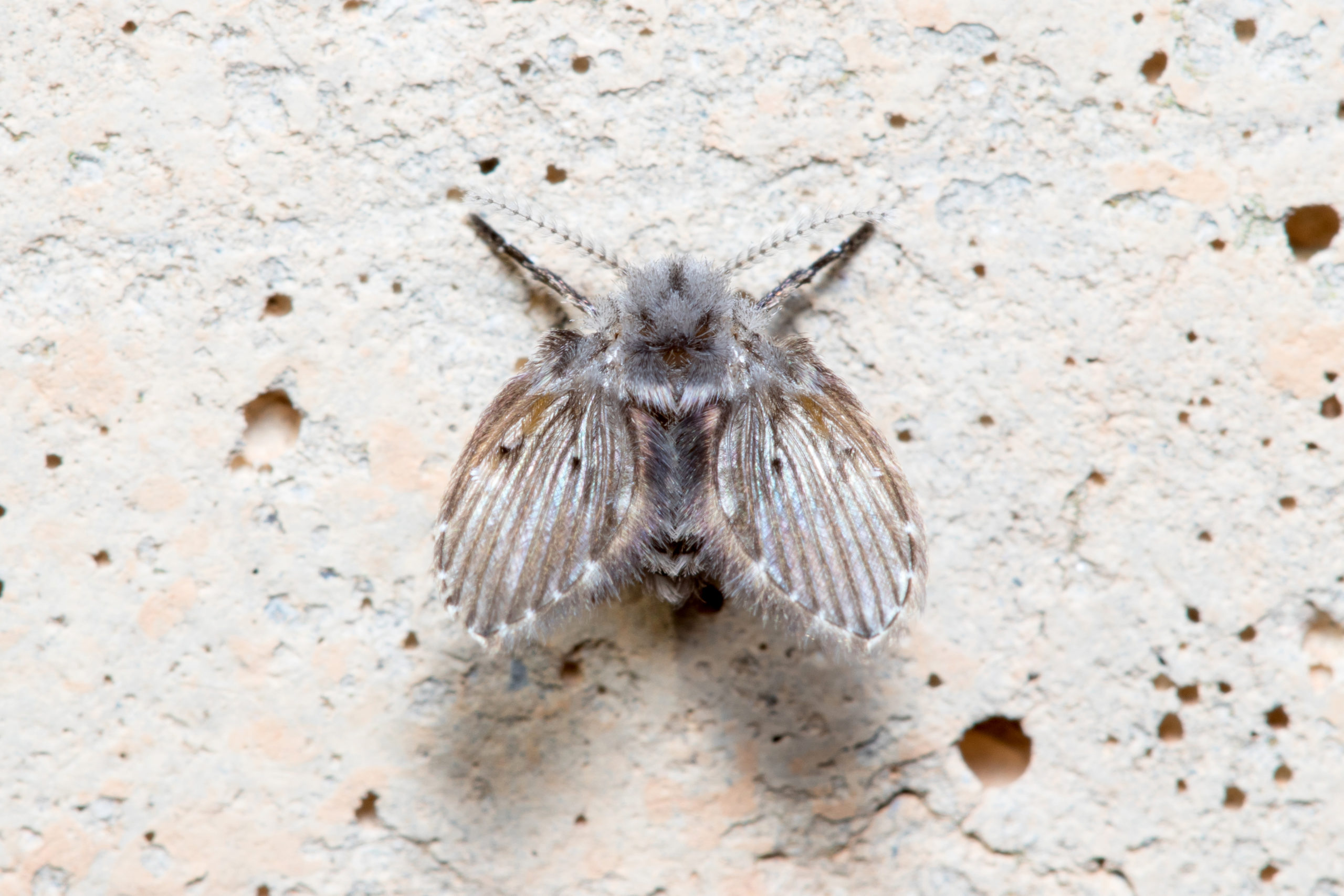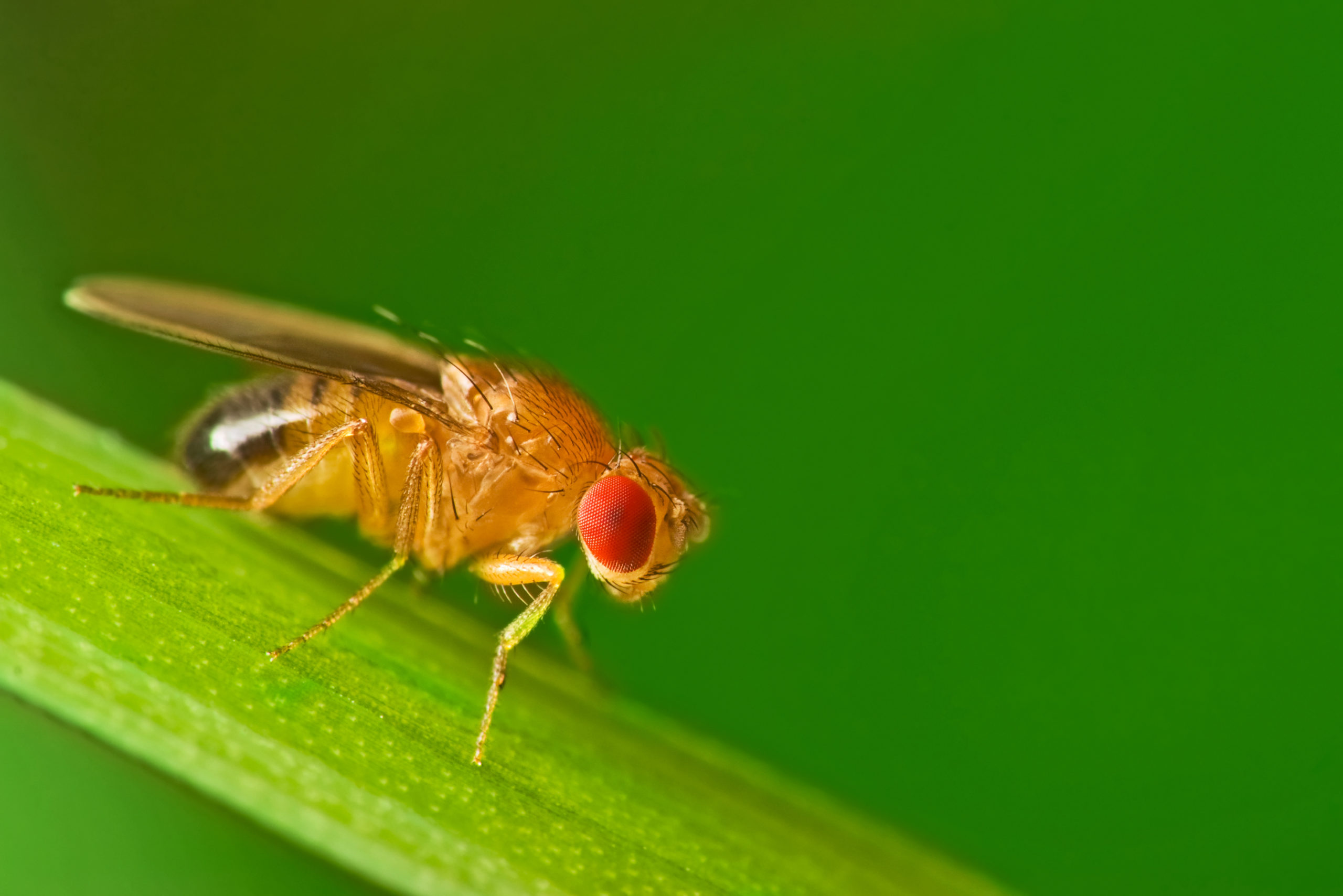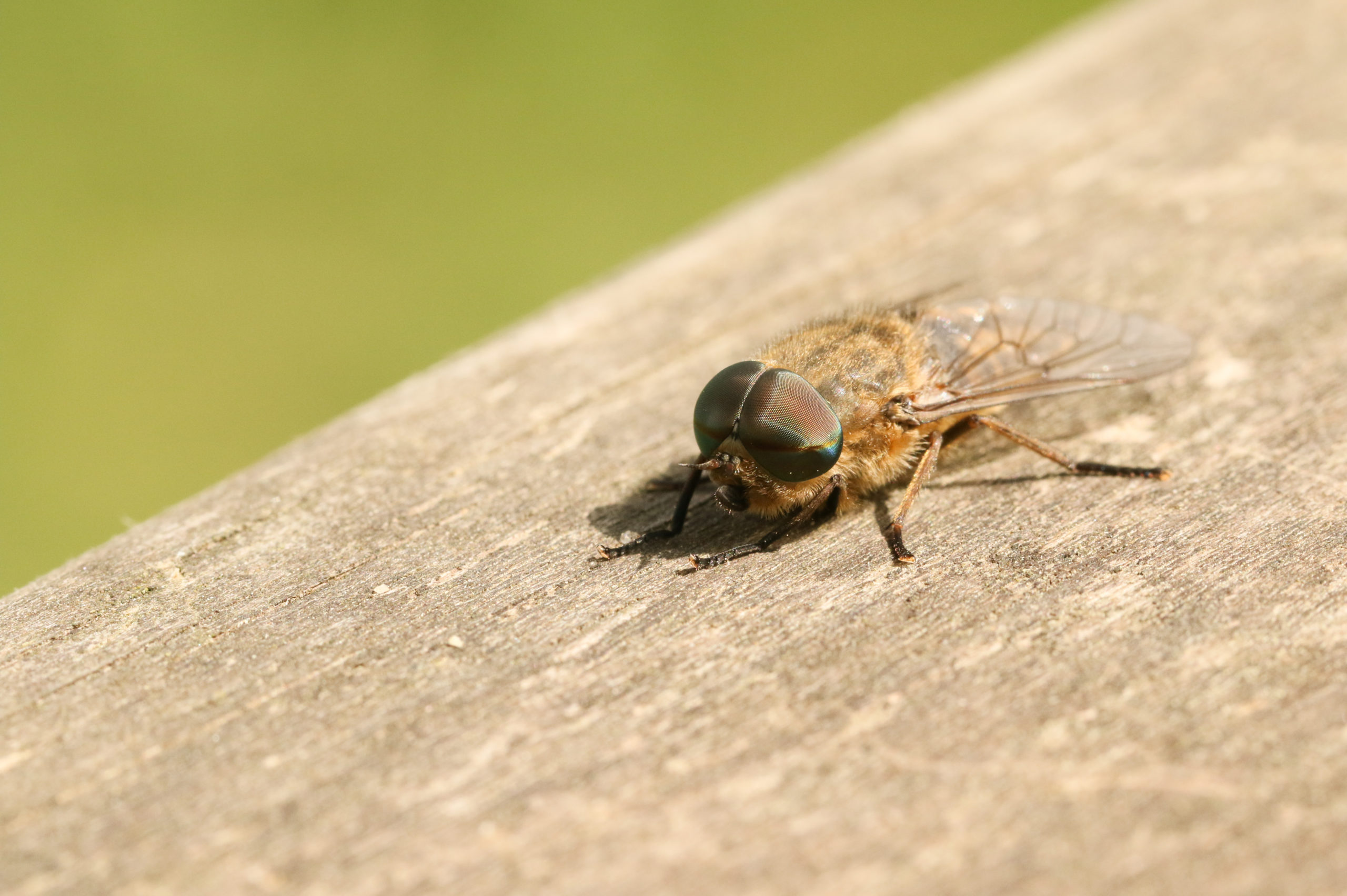The 4 Most Common Pesky Flies
The 4 Most Common Pesky Flies
There’s no way around it: flies are annoying. They seem to solely live for the purpose of flying around our heads and landing on our food, which is most definitely unappetizing. The few common species that we see buzzing around our homes and businesses actually have different lifestyles and personalities, even though they all seem the same on the surface. Let’s look at the four flies that most commonly pester our homes, and determine the actual differences in their diets, preferences, and ways of life.
House Fly

Life: This type of fly is probably the one you think of when you hear about this pest. The house fly gets its name from the fact that they seem to love staying in and around our homes. Their eggs are laid on dead and decaying materials so that the larvae has food right when they hatch, much to our disgust. There are about 75 to 150 eggs laid at one time, which means that there will soon be flies swarming the place if they continue to have a food source since house flies will stay within half a mile to two miles from their birthplace. Their life cycle lasts about a month, just long enough to annoy humans and pets to no end. The preferred temperature of house flies is around 83 degrees Fahrenheit, hence why they thrive in spring and summer.
The way that flies seem to adhere to any surface is impressive, but gross when the facts behind it are revealed. House flies have a glue-like substance on their feet that allows them to walk anywhere, including walls, ceilings, and rough surfaces. They also have taste receptors on their lower legs and feet that allows them to taste their food by walking before eating. But because they walk all over their food that tends to be of the dead or rotting variety, they carry all kinds of bacteria and disease wherever they go. Salmonella and E. Coli are just a couple of the pathogens that house flies are known to carry. Needless to say, you don’t want these pests crawling all over your delicious plate of food at a backyard barbecue.
Diet: The short answer to the question of what house flies eat is everything. Our homemade meals and a pile of garbage are the same to a common house fly. They are always salivating even when not eating, so they constantly look for a source of water as well. But this isn’t the only sustenance they drink; house flies actually have to drink everything they eat! They don’t have the mouth parts needed to chew, so they have to drink their food. House flies have a predictably disgusting way to consume their food because of this. They regurgitate a digestive liquid to break down their food, then use their long mouth part (proboscis) to drink it. So the old theory that flies vomit on everything they touch has some truth to it, much to our chagrin.
Prevention: There are a few ways to prevent house flies from plaguing your backyard, and they tend to work on most types of flies. They are difficult to kill singularly, since their compound eyes give them a 360 view of everything. One easy way to prevent them from even being attracted to your yard is to eliminate any potential egg-laying sites. If you have some land, make sure there aren’t any decaying crops or critters lying around for flies to inhabit. Also, keep the garbage level down both in the house and in the big trash can outside. Garbage is a major draw for house flies, no matter what is in it. If you like to open your windows and sliders often, make sure the screens don’t have any holes in them. Flies in the backyard are annoying enough, but house flies in the actual house are even more frustrating.
Drain Fly

Life: These flies are often mistaken for moths, and for good reason. They are covered with dense hairs that gives them a fuzzy appearance, and are brown to black in color. They also hold their wings above their head when resting; this habit gives them the nickname “moth fly.” Drain flies can lay 100 to 200 eggs at a time that hatch within a couple of days, which is how they can quickly turn into a big problem. True to their name, drain flies live in wet areas that are usually bathroom or kitchen sinks. They will also stay on walls near any kind of moisture, in garbage disposals, and within pipes. Basically, any dark and damp area is extremely attractive to the drain fly.
They aren’t great at flying, so drain flies favor hopping over straight flying. They are most active in the evenings when the light outside of the drains draw them out. They can certainly cause problems, but maybe not in the way that you have heard before. Thankfully, drain flies do not lay eggs in people or act as parasites in any way. They are more interested in the drain substances than in humans. However, they do pose a problem when their deceased or drying wings cause allergy symptoms in us. This is similar to the effect that cockroaches have on people if they are present long enough; the dust on the insects activate common allergies in people that are susceptible to them. So while they like to stay deep inside drains and pipes, drain flies can cause deeper problems if they are not taken care of sooner rather than later.
Diet: Drain flies also have a disgusting diet by human standards, as you can imagine since they live in drains. The larvae are the main consumers of organic material within drains, since the eggs are laid within pipes. Food sewage, hair, buildup, and decaying matter are all favorites of the larvae. Drain flies can also inhabit compost piles, damp leaves, and dung, so they get their organic material from a variety of places. Adult drain flies actually enjoy food outside of the sink, so they really just return to the drain to lay eggs. Adults enjoy polluted water and nectar, so you can find them in the garden on occasion. While drain fly larvae eats pipe buildup and helps us in that way, they shouldn’t be kept around if only for the fact that they are dirty insects living in your home.
Prevention: There are not many actual effective products to prevent drain flies besides simply keeping the sink as clean as possible. Also, running hot water down the drain once in a while should be enough to prevent them from staying in the drain, since the heat will kill any that are in there. There are also pipe brushes you can purchase from the store that you could push down the drain if you believe a drain fly family is living in it. Check for any leaks around pipes, showers, and sinks in the home, since those are very attractive to drain flies. Eliminate any standing water in the yard by dumping out plant drainage trays, shaking out tarps, and wiping off surfaces with collected water.
Fruit Fly

Life: This tiny menace is drawn to all kinds of food and garbage, so they are often seen around outdoor parties or homes with a lot of fruit displayed on the kitchen counter. Fruit flies have red eyes with a tan and black body. They live for about 40 to 50 days, and can lay up to 500 eggs during their short lifetime. They also take 8 to 10 days to fully develop, so most of their lives are spent as adults. Fruit flies are most active in the fall, even though they are sensitive to temperature and lay more eggs when it’s hot outside. They are attracted to a variety of moist substances and containers, like buckets, drains, trash, dirty sponges, and empty bottles. They need fermenting materials and damp environments to survive, which is why they are commonly found in areas with lots of trash.
One interesting fact about the fruit fly is its strange relation to us, genetically speaking. Scientists have determined that 75% of disease-causing genes found in humans are also found in fruit flies! This is why the insects have been very helpful in research for cures for many common diseases that people struggle with. But since fruit flies stay inside garbage and decaying fruit, it’s safe to say that we are much different from them in terms of habitats and diets.
Diet: You likely guessed the main diet of fruit flies based on their name. The eggs are often laid in decaying fruit so that the larvae can immediately start eating once they hatch. The adults tend to stay in the organic material throughout their short life so they never have to stop eating. They also love yeast, which is found in beer and wine in addition to bread. The fermentation in alcoholic drinks is also a main draw for fruit flies, which is why you may find tiny flies going for a swim in your drink at an outdoor party. But their love for decaying organic material makes them more of a pest than a partier in the end.
Prevention: The best way to prevent fruit flies from crashing the party is to keep all food containers and trash cans sealed. Pests can’t get into tightly sealed receptacles, no matter how persistent they are. Keep all fruits sealed in bags or containers in the refrigerator, except for bananas and oranges since they have natural barriers, and make sure to remove spoiled fruit before they find it. Rinse out any empty bottles and cans, especially ones that held alcoholic drinks. The smallest amount of leftover beer or wine can attract fruit flies, which means a headache for you later.
Horse Fly

Life: This final common fly is known for its massive size and frustrating ability to bite mammals. Also referred to as deer flies, horse flies have mandibles that can cut the skin of many animals and humans in order to drink the warm blood after being drawn to the source from the carbon dioxide that they emit. But similar to mosquitoes, female horse flies are the only ones that bite. They can grow to over one inch in length, and often stay near roads or in large buildings for safety and food. The larvae lives in aquatic areas, which is likely why adult horse flies stick to moist areas, especially for laying eggs. Some varieties live for only a few days, and all horse flies like to spend time outside in sunny areas. Their one pair of wings is enough to carry their large, hairy bodies to food and water near their place of origin.
As stated earlier, female horse flies will bite mammals for the blood. Their name comes from their habit of swarming horses, especially their faces, to bite them and drink their blood. They need it as a viable protein source for their eggs, and there is definitely blood to be had from their bites. Horse flies can also inject bacteria in their victims, which can lower growth hormones in animals if they are bitten enough. It will be pretty clear if you have been bitten by these monstrous flies since they can cause bleeding of the wound. A welt will likely develop from the bite as well, which is just another painful effect of this bite. A cold compress on the area should bring the pain and swelling down, but be sure to seek medical attention if it doesn’t go down or if it seems to be infected.
Diet: Clearly, the diet of female horse flies is warm blood. But other kinds of horse flies have a less painful variety of food. Male horseflies eat flower nectar, rivaling pollinators for this sweet substance. Horsefly larvae actually eat other larvae, so the taste for organic vital substances starts young with this pest. On the bright side, the larvae can reduce the pest population even slightly, but horseflies are pests in their own right that should not be kept around for very long if possible.
Prevention: People who don’t have a barn or a lot of land likely won’t have to deal with horseflies too much. But anyone with livestock or water on their property can tell you that it is not fun to have these flies around. One way to prevent horseflies is to eliminate all standing water in the yard if possible, similar to preventing other flies. Drainage trays, tarps, decorations, tables, and play equipment can all hold a lot of water after a rainstorm, which is good news for horseflies and bad news for people. Also, most bug sprays are effective against horse flies. Make sure to use it before spending an extensive amount of time outside, like on a hike or at a party. Horseflies are attracted to trash like all other flies, so keeping garbage contained and sealed is a great way to prevent these painful pests.
Fly Away From Pest Problems with Pointe Pest Control!
Flies are very annoying pests, especially when their swarms don’t seem to go down in number no many how many meet the fate of a fly swatter. But our pest control services do not service flies, but we do still provide you with the pest-free space you deserve. Contact our team to learn how we can rid your home or business of specific flying pests so that you can retire that fly swatter back into the closet.
Citations
6 horsefly facts you need to know? The keys to fly control. (n.d.). Horse Racing Sense. Retrieved April 28, 2022, from https://horseracingsense.com/horseflies-facts-you-need-to-know/
15 fascinating facts about fruit flies. (2016, December 15). Mental Floss. Available at https://www.mentalfloss.com/article/88228/15-fascinating-facts-about-fruit-flies (Accessed on April 28, 2022).
Bertone, M. (2014, September 10). 7 cool facts about drain flies and their kin. Your Wild Life. Available at http://yourwildlife.org/2014/09/7-cool-facts-about-drain-flies-and-their-kin/ (Accessed on April 28, 2022).
Drain flies. (n.d.). Hulett Environmental Services. Retrieved April 28, 2022, from https://www.bugs.com/bug-database/flies/drain-fly/
Facts about horse flies. (2020, June 1). Maggie’s Farm. Retrieved April 28, 2022, from https://maggiesfarmproducts.com/blogs/bug-help/horse-flies
Fruit flies. (n.d.). OSU Extension. Retrieved April 28, 2022, from https://extension.okstate.edu/programs/digital-diagnostics/insects-and-arthropods/fruit-flies-drosophila-sp./index.html?Forwared=entoweb.okstate.edu/ddd/insects/fruitflies.htm
Fruit flies. (n.d.). Terro. Retrieved April 28, 2022, from https://www.terro.com/fruit-flies
Fruit fly facts, identification, and control. (n.d.). Assured Environments. Retrieved April 28, 2022, from https://www.assuredenvironments.com/pest-library/profile/fruit-flies
Jacobs, S. (2017, March 13). House flies. PennState Extension. Available at https://extension.psu.edu/house-flies (Accessed on April 28, 2022).
Horse flies. (n.d.). Pest Help. Retrieved April 28, 2022, from https://www.pest-help.com/pests/flies/horse-fly/
Horsefly. (2022, February 12). AZ Animals. Retrieved April 28, 2022, from https://a-z-animals.com/animals/horsefly/
House flies (n.d.). Pest World. Retrieved April 28, 2022, from https://www.pestworld.org/pest-guide/flies/house-flies/
Rentokil Pest Control Ireland (2018, April 9). 10 interesting facts about house flies you never knew. deBugged: The Pest Control Blog. Available at https://www.rentokil.ie/blog/10-interesting-facts-house-flies/ (Accessed on April 28, 2022).
Shade, D. (n.d.). Can drain flies lay eggs in humans?. Goodbye Drain Flies. Available at https://goodbyedrainflies.com/identifying-flies/drain-fly-eggs-in-humans/ (Accessed on April 28, 2022).
Request a Free Quote Today
(We do not share your data with anybody, and only use it for its intended purpose)


